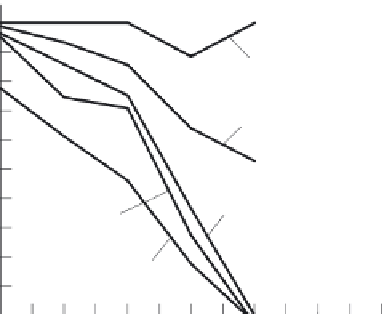Environmental Engineering Reference
In-Depth Information
Long-term historical data sets often provide valuable insights. For example,
records have been kept for up to 70 years in the case of populations of bighorn sheep
(
Ovis canadensis
) in various desert areas in North America. By grouping these into
classes according to their population sizes at the commencement of record keeping,
it becomes clear that the smaller the population, the greater the risk of extinction
(Figure 5.3). Let's set an arbitrary defi nition of the necessary minimum viable
population, as conservation managers often do, as one that will give at least a 95%
probability of persistence for 100 years. Figure 5.3 can be explored to provide an
approximate answer. Populations of fewer than 50 individuals all went extinct
within 50 years while only 50% of populations of 51-100 sheep lasted for 50 years.
Evidently, for our minimum viable population we require a population with more
than 100 individuals: such populations demonstrated close to 100% success over
the maximum period studied of 70 years.
A similar analysis of long-term records of various species of birds on the Channel
Islands off the Californian coast indicates a minimum viable population of between
100 and 1000 pairs of birds (Thomas, 1990). These unusual data sets are available
because of the extraordinary interest people have in hunting (bighorn sheep) and
ornithology (Californian birds). Their value for conservation, however, is limited
because they deal with species that are generally not at risk. It is at our peril that
we use them to produce recommendations for management of endangered species.
There might be a temptation to report to a manager 'if you have a population of
more than 100 pairs of your bird species you are above the minimum viable thresh-
old'. But this would only be a (reasonably) safe recommendation if the species of
concern and those in the study had very similar life-history characteristics and if
the environmental regimes were similar, something that it would rarely be safe to
assume.
One fi nal point in the context of lessons for conservation managers from correla-
tional data concerns the species traits I discussed in Section 3.4.2. There you saw
that extinction risk is higher for large-bodied,
K
-selected species because of their
low reproductive rates. Thus, a link becomes clear between individual life-history
traits and population processes. The message for managers is clear - pay particular
attention to large-bodied species at risk.
Fig. 5.3
The percentage
of populations of
bighorn sheep that
persist over a 70-year
period is lower when
the initial population
size is smaller. (After
Berger, 1990.)
100
90
80
70
60
50
40
30
20
10
0
10
101+
51 -100
31-50
16 - 30
1-15
20
30
40
50
60
70
Time (years)





























































Search WWH ::

Custom Search